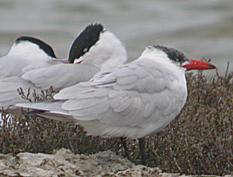Caspian Tern
|
|
| Caspian Tern | ||||||||||||||
|---|---|---|---|---|---|---|---|---|---|---|---|---|---|---|
 Caspian Terns loafing on the Coorong, South Australia. | ||||||||||||||
| Scientific classification | ||||||||||||||
| ||||||||||||||
| Binomial name | ||||||||||||||
| Sterna caspia Pallas, 1770 |
The Caspian Tern (Sterna caspia) is the largest tern.
Adult birds have black legs and a long thick red-orange bill. They have a white head with a black cap and white neck, belly and tail. The upper wings and back are pale grey; the underwings are pale with dark tips.
Their breeding habitat is large lakes and ocean coasts in North America including the Great Lakes and locally across much of Europe, Asia, Africa, Australia and New Zealand. They usually nest on the ground among debris or sometimes on floating material.
North American birds migrate to southern coasts, the West Indies and northern South America. Eurasian birds winter in the Old World tropics.
These birds dive for fish, hovering high over the water and then plunging. They also sometimes eat insects or young and eggs of other birds.
The call is a loud heron-like croak.da:Rovterne pl:Rybitwa wielkodzioba fi:Räyskä
